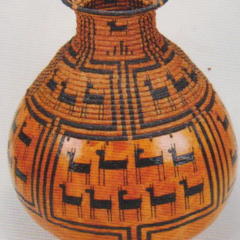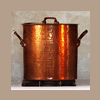Search the Community
Showing results for 'wok'.
Found 5,180 results
-
Welcome to eGullet, Steven! Here are a few topics on outdoor cooking equipment. Grill Recommendations: Gas, charcoal, both? Merged topic. Food Smokers: The Topic: What type to purchase? Wok Burners: The Topic Edited to add one more for the truly committed: Homemade Tandoor
-
I have the Cuisinart electric wok, from Amazon, and I LOVE it! It draws 1800 watts (!) and cooks super fast. It heats up in no time. One might need a dedicated outlet for it (I rewired my kitchen ages ago and everything like the micro and wok have their own breaker). DO NOT believe that all electric woks are the same! This Cuisinart is over the top. The only, and I really mean only, complaint is that the non-stick coating (over the stainless) is not super durable. But then I am very aggressive and others might find it OK. It could also have benifitted from an additional long handle on the side, for scooping the food directly into dish without use of a hand scoop. I would buy another of this model wok YESTERDAY if i needed it! It DOES heat uip enough to sear or do anything a regular wok does! Ray
-
An electric wok simply cannot supply the BTU's(heat) needed to cook with a wok, you end up stewing, rather than frying. Even with 15K BTU/hr burners on my Viking, its really not enough heat but I make do. You certainly can use the gas burner on your BBQ.-Dick
-
For last week's minor Chinese feast we had a gas stove, two carbon steel woks AND three crockpots and the crockpots acted as keep it warmers, particularly for the soups.
-
In general, as noted, electric woks aren't good at stir-frying, but they do have other good uses: - As noted above, it can make something remarkably like paella, even down to the crusty bottom. Actually, my electric wok is one of my favorite tools for rice dishes. - The shape and heat control on an electric wok makes it good for braises/stews. You can even sear the meat and braise it all in the same wok. - You can use it as a warmer/server/extra burner. It may not be ideal for every use, but (with a little creativity) it is remarkably flexible. I've used mine to mull cider, for instance.
-
It's important to differentiate between various "spicy" ingredients. Mustard, wasabi and horseradish, for instance, affect your nasal passages pretty directly -- take a hit of one of those and your eyes will water and your nose will run immediately. Whereas capsaicin, while hot on the tongue, doesn't really affect mucus membranes when you eat foods that contain it. The circumstances in which capsaicin come into play are if it's dispersed in cooking -- as when you lean over a wok when you're cooking chile flakes in hot oil -- or if you inadvertently sniff cayenne (well, yes, I have, in case you're wondering -- don't ask). Not to mention touching mucus membranes with capsaicin-covered hands. But just eating foods with chiles doesn't do much to your nasal passages.
-
That was one weird episode and I can't for the life of me see how Ashley got sent home. She is not my favorite, but dang. Ash did nothing and admitted it. Mike and Robin's stuff looked horrible and they were at each other's throats. Robin should have been gone looooong ago. My biggest beef is making them cook in the house on Macy's "Mr Wok" and such. Come on. And the preview looks like they get to do it again next week.
-
I vary the ingredients I add to my fried rice, but the one thing I don't ever vary is the technique I use for cooking the rice. I typically use Basmati rice--probably not the first choice of most home cooks. I prefer the long-grains and the earthy scent of Basmati rice. I soak and rinse the rice in at least 5 changes of water to remove as much starch as possible before I cook the rice in a basic rice steamer. After the rice cools down, I cover the rice and let it sit overnight to allow the rice to chill down and any remaining starch to set back down. On day two, I'll separate the chilled rice in my fingers so that I'm not faced with big chunky rice balls. I was getting frustrated in recent years when I cooked fried rice because it continually came out "soggy" and just didn't have the same texture as fried rice from a restaurant. (Obviously I didn't realize that it was probably due to the fact that I don't have a high-output flame heating the wok on my home stove). My cooking technique may sound a bit odd, but it seems to work for me in coming close to replicating the fried rice I find in restaurants. I heat a large, non-stick skillet over high heat. No oil, no butter no fat, just a dry, non-stick skillet. Then in goes the rice for a blast of dry heat. The rice gets a little crusty and a few black, charred bits on it--just the way I like it. I stir the rice around just for a minute or two, then in goes the garnishes--ham, egg, chinese sausage, shrimp, carrots, whatever. Next in the pan is a few dashes of sesame oil and a slug of soy sauce. On a rare occasion I'll add a dash of rice wine or Chinese black vinegar. I always finish my fried rice with a scattering of peas and chopped green onion.
-
At the restaurant I work at, whoever is doing the Meat/Fish station has to prepare family meal for the 2-3 dishwashers at the end of the night. Sometimes we have random bits of meat (sometimes hot dogs) that need to be used up. I often make the guys big plates of fried rice. I do it in a wok, like this: -High heat -squirt of oil -finely sliced red Anaheim chiles and scallions -spoonful of our Ginger Garlic Relish (raw ginger, garlic, scallions, cilantro, soy sauce, and vegetable oil pureed coarsely) -healthy doses of both soy sauce and sweet soy (Kecap Manis) -leafy green vegetable that we have extra of...bok choy, water spinach, brussels sprouts leaves, etc. -diced meat -large amount of steamed rice -toss to combine -lift handle of wok to move everything to the other side, leaving an open space in the wok, and add 2-3 beaten eggs per serving -let the eggs scramble a little, then toss again to combine and coat the entire thing lightly in egg -empty onto plate, finish with a lot of Sriracha (our dishwashers are all from Ghana/Ivory Coast, so they like it SPICY)
-
It's usually very simple, as fried rice is usually a quick lunch or side dish in my house: chopped scallions, wok-scrambled eggs, ordinary white rice (cold, a bit dry), light soy sauce, and a bit of Maggi, which I started adding ages ago when I was trying to duplicate a restaurant's recipe. (These days I use a bit of La Choy soy sauce instead -- it's a horrible soy sauce, but a pretty good gluten-free substitute for Maggi). If I have Chinese sausage I'll add some, and sometimes I do a yang chow-ish variant with shrimp and peas and whatnot, and sometimes I use rice that was cooked in a Chinese-style chicken stock or take a Thai approach with fish sauce etc., but the above is what I do most of the time.
-
I think they absolutely do. One thing I noticed is that the pre-peeled are not at all sticky. They're lacking whatever fresh garlic has (essential oils?) that make garlic so potent, the sticky substance that, before you wash it off, makes you want to eat your fingers it smells so good. You'll find the same thing missing with pre-peeled shallots (complete waste of money, IMO). When cooking Chinese, I always have to be careful not to let the garlic stick to the wok. With the pre-peeled stuff, it doesn't stick at all. Non-stick garlic might have some appeal, but not when the flavour is compromised.
-
Q&A -- Understanding Stovetop Cookware (2009-)
v. gautam replied to a topic in The eGullet Culinary Institute (eGCI)
I have a question for those who have used/compared Vollrath, Paderno G1000 and Sitram Profeserie or Catering lines for the rondeau/braziers, 7.6 qts, 11.4 qts and above. There is also a Paderno GG1100 series, much more expensive than the 1000 line. Vollrath 77760 series is 8 gauge stainless steel, i.e. o.1719 inches sheet metal. The 44760 series is 16 gauge, 0.0625 in, and I am not interested in this. Vollrath also has an interesting large size Stir fry pan, a round-bottomed handled wok, for all practical purposes. Thank you for your input & advice. Gautam. -
I guess an advantage of being older than the moon is that I saw and remember an episode of "Wok With Yan" or "Yan Can Cook" when he shows the spoon-for-peeling method. Used that method always since then, and eternally grateful to him. Ray
-
Board mostly, but it depends on how quickly I need to have things ready and how much board space I need. I'll move things to bowls, if I need the board, and I tend to put things in bowls for stir frying, because I want everything ready to go into the wok immediately when it's called for. I'll also move things like raw meat off the board, if I want to hold them for some reason and clean the board in the interim so I can do other things on it or put cooked food on it without worrying about cross contamination.
-

What cookware are you the most obsessive about?
Octaveman replied to a topic in Food Traditions & Culture
Of course, my knives but other than them...probably my woks and cast iron frying pans. -
Please thank my august teachers. I am merely a fool who is trying to convey, most imperfectly, their knowledge, traditions and lore to a bigger world. Thank you for your kind thoughts. Additional note for the liver: a Joyce Chen 14 inch non-stick wok works well in the preparation above, as does any ordinary 14 inch flat/round bottomed wok. An interesting observation: in some liver preparations, e.g. the dry spice Chorchori upthread, the proportion of potataoes to liver is almost 1:1. The flavored fat forms the GRAVY, and therefore is scant. The clinging spice, the film of flavorful oil (ideally neutral like peanut oil or best, ghee) that carry with it the overtones of mustard oil and fresh ghee are mixed in with plentiful rice or consumed with great hunks of bread. Thus, the net effect is that of almost a seasoning. That is why the base is made so rich, and the rice made moist. There are several degrees of cooking rice moist in Bengal, between dry and congee. This actually is a fine art, and dishes are prepared to favor the unique textures of different varieties of rice cooked to different degrees of moistness. It also matters whether things are eaten steaming hot, tepid or cool, and what temperature the rice is for each side. These fine points of West Benga cuisine are rapidy becoming extinct, within a single generation. Here, it should distinctly hold its shape but be moist enough to easily absorb the spice and be smashed and become a "ball''. Sticky rice might be good too, though it is never customarily eaten in West Bengal. In Kashmir Pandit cooking, liver is cooked in a sweet-sour gravy fragrant with mustard oil where potatoes are the star and liver actually becomes a flavoring. This is a very interesting way to consume liver, and a little goes a long way.
-

Cambodian/Khmer Cooking
Chris Amirault replied to a topic in Elsewhere in Asia/Pacific: Cooking & Baking
When I can find good looking oyster mushrooms, I try to make David Thompson's simple, delicious mushroom salad. I made it early, blanching then shocking the beans and then quickly cooking first the oysters then the shiitake. A few more ingredients and... lunch: I made two dishes, as I mentioned above. I was going to sub out the black for green peppercorns, but then decided to stick to the Riviere recipe for shrimp with black pepper and cilantro: This very simple recipe is really good. The step that intrigued me was adding the shrimp, garlic, and oil all at once to the caramelizing sugar. I made this in a wok -- mistake -- so I had a hard time reading the darkness of the caramel. I added the shrimp too early, stopping the caramelization before it was sufficiently dark. As a result, I was worried about overcooking the shrimp, so I removed them to reduce the sauce and then add the pepper, fish sauce, and coriander. Next time: no wok (stainless saute pan), less oil, and darker caramel. But this was great, the sweetness of the caramel and shrimp playing off the bite of the pepper. I added minced coriander root to the dish to brighten it up a bit, which was a good idea. Here's the grilled eggplant with pork. I had variations of this dish in Chiang Mai, though with holy basil instead of cilantro, and so I subbed that in. I also added a couple of minced kaffir lime leaves -- again, like the coriander root above, to add a bit of an edge. Though it looks like -- well, you know what it looks like -- it's a truly classic dish. The key is to let the pork and aromatics fry for a good long while, until the meat has started to brown. That gives a nutty quality to the dish that is lacking otherwise. I added the sugar a bit early, to let it caramelize slightly as well. Very eager to continue with the book. However, I'm wondering if it's a bit cleaned up for the generic reader. In particular, I'm wondering how bitterness plays in the cuisine when not framed for Westerners.... -
If they became translucent it is probably rice noodle. Korean potato noodles are brownish in color (uncooked) and will turn golden brown-translucent when they are done (cooking). They have a nice elasticity to them, which makes it hard to cut with your teeth, you would have to eat the whole strand. To fix japchae noodles, soak the bunch in warm water for about 5 minutes. Drain and add to your wok. Add about a cup of water and cook until all the water gets absorbed and keep adding water if it doesn't look like it's enough. You can also boil it before stirfrying but the lazy wife version is just to simmer in the wok/pan that you are using until they are done. Will post pics of japchae noodle packs later for clarification.
-
Thanks Chris I appreciate it. I know how to braise, steam and deep fry other foods. Have not jumped in too deep with Chinese cooking although I just bought quite a few items at the market. From posting in another thread I am figuring out that I don't have my regions straight. I was mentioning Tonkatsu sauce and didn't realize that it's Japanese so I might be a challenge. Products I have on hand right now are light soy, dark soy, shaohsing wine, black vinegar, oyster sauce, chili bean paste, chili paste, chili oil, sesame oil and a few other things. I have a wok. It's just a 14 inch carbon wok. One of the 20 dollar ones. It's actually proved to be a better tool than some of the more high dollar name brand ones. Yes I was checking out the pictures and recipes and saw a few that caught my eye. Am definitely going to try the imperial shrimp. My passion has pretty much been dishes that are on the deep end of the scoville scale. I like food so hot that my head sweats. I would love to perfect a good chicken or pork in garlic sauce that I could pile some peppers in. Thanks again for your help. I'll try to limit the dumb questions to a minimum.
-
Rona is right: hzrt8w's home cooking tutorials are a great place to start. There are lots of other topics in the China cooking & baking forum to check out, so snoop through there; I can see you've already found the pictorial guide to Chinese ingredients. If you're use to sauteed meat and two veg and are just starting out with many of these ingredients (various tofu products, vegetable starches, shaoxing, conpoy, pork belly, Chinese pickles, on and on), simply buying them and cooking with them will teach you a lot. How well versed are you in fundamental Chinese cooking techniques? Do you know how to steam, braise, deep-fry, and use a knife and a wok? If not, I'd grab Barbara Tropp's Modern Art of Chinese Cooking and read it, as you'll be able to get an excellent grounding in technique while making her recipes. Finally, I daresay that many of us here will do our level best to help out! Pick a recipe you're interested in, get the ingredients, and start documenting. We'll lend a hand!
-
Sony, Thanks. You mentioned marinating: Yes, the texture of the chicken could be improved, and marinating, with salt, that is, a 'brine', should help. I've never marinated chicken; maybe I should! Good news: The chicken chunks were not all hard and dry from over cooking. Bad news: The chunks were not 'succulent' or spontaneously separating along the muscle fibers. Marinating in brine, etc. might help the texture. Some long sous vide heating might also help the texture of the chicken, but for that I would need a constant temperature water bath and have yet to construct one! The step of saute of the chunks sounds promising: I omitted some data I got from some earlier work with chicken. Basically I took a 14" Chinese steel wok with about 1 C of cooking oil and, outdoors, on a propane fueled burner intended for deep frying turkeys (claims 170,000 BTUs per hour), did a light saute of cut chicken pieces (wings, drumsticks, thighs, breast halves, backs) and, separately, onion, carrot, celery, and mushroom pieces. Lessons: (1) When made a stock of the chicken pieces, got nearly no 'scum'. So, apparently the light saute in the oil was enough to 'set' the chicken proteins and reduce scum formation. (2) The oil got some unbelievable amount of flavor from both the chicken and the vegetables. Used some of that oil along with butter in the roux and got MUCH more sauce flavor. Broadly a suggestion is that such fat, used in roux, can provide much more sauce flavor than water based liquids. So, for the light saute, use the same butter will use in the roux! Also, soften the vegetables in that butter! Or, if suspect that chicken scum would contaminate the fat, then saute the chicken in just cooking oil and discard it and saute the vegetables in the butter to be used in the roux! For the present dish, I was poaching raw chicken chunks, and no doubt they wanted to throw off 'scum' which, in the procedure I used, I had no opportunity to skim. So, likely I have the scum in the final dish, and it may be hurting the flavor. So, if my lessons from the wok experience are applicable, doing a light saute of the chicken may 'set' the proteins, cause the chicken chunks not to release scum into the poaching liquid, and improve the flavor of the final sauce and dish. You mentioned garlic. I intended to include some with the vegetables but just neglected to do so -- an error. I agree that garlic might help. I didn't think of the paprika and nutmeg. They might be terrific. I was intending a light colored sauce, like I got doing much the same with scallops, but just accepting a darker sauce and paprika and nutmeg might be an even better direction. I don't know why the sauce color is so dark; my guess is the water from simmering the mushrooms. So, I've been thinking I should discard that water and just keep the cooked, shrunken mushrooms. I still have about 3 quarts of this dish for dinners (needs improving but is good enough to eat) over the next week or so but will need more and do another trial soon! From the shellfish poisoning, a month ago, have nearly fully recovered; maybe will fully recover. Thanks.
-
My favorite recipe for pasta carbonara with asparagus. Adapted from Good Tastes by Sherry Golden, a little known but worthy cookbook from the 1980s, now out of print. SPAGHETTI AND EGGS WITH ASPARAGUS AND MUSHROOMS Adapted from Good Tastes by Sherry Golden 2 lbs fresh asparagus 4 TB butter 1 1/2 cups chopped onion 4 large cloves garlic, minced 1/2 lb mushrooms, sliced 1/2 cup dry Marsala salt & freshly ground black pepper 4 extra-large eggs 1 1/2 cups freshly grated Parmesan cheese, plus extra for serving 2/3 cup milk 4 TB olive oil 2 tsp salt 1 lb spaghetti, linguine or vermicelli Trim off any woody parts of the asparagus. Keep the tips whole and cut the stalks into 1/2" diagonal slices. If desired, warm some plates for service. Heat the butter in a large saute pan or wok, and saute the onion until it is tender. Add the garlic, asparagus pieces, and mushrooms, and saute over high heat until the asparagus is crisp-tender. Add the Marsala and continue cooking until the Marsala is completely absorbed and evaporated. Season lightly with salt and pepper. Set aside. In a bowl combine the eggs, Parmesan cheese, milk, olive oil, 2 tsp salt, and more black pepper if desired. Set aside. Cook the pasta until it is al dente. Just before the pasta is done, reheat the asparagus mixture until it is very hot. Drain the pasta and immediately add it to the asparagus mixture. Turn off the heat, or reduce to very low heat. Add the egg mixture and toss quickly until the pasta is coated with lightly thickened sauce. Taste and adjust for seasoning. Serve immediately on warm plates, with extra grated Parmesan on the side. Yields 4-6 servings.
-
If you haven't been, get there. 217 Como Ave., St. Paul (intersection of Como and Marion). I'm sure it's in a former lumber yard or some such type of place, and I'm sure that the the covered lumber-storing-type places (ala Menards) have vendors in the summer. But, at this time of year, it's all about the two very large buildings, with all sorts of things. All sorts of things include loud music -- DVD's and CD's. Lots of clothing -- all florid -- including shoes of toe-pinching and back breaking type. Lots of polyester. Want "Virgin" soap ("clinically proven) (we were sure this was to wash away the sins :-) ). A good array of cooking stuff, including rice cooker, stainless steel spiders, woks for a crowd, and more rice spoons than one can shake a stick at. But, in the East Building, a very nice food court. So, for breakfast today, from the Nyob Zoo Kitchen (farthest right as you face most of the places: Som Tam (sp?), aka Papaya Salad. This was outstanding, and once the cook realized that I called it Som Tam (Thai) or Tom Sam (Loatian), he realized I wasn't his typical Farang. This was truely wonderful, and we must have gotten a quart for about $5.00. Also notable was the curry noodle soup. Their eggrolls were forgettable, but then again, they're not something that I waste fat and calories on. If you are into egg rolls, there is another place that's about half-way toward the west side of this bank of food stalls that looked better. I've had preferred to try some of the soup things with all sorts of odd animal parts instead, but I was with a group of folks. There were many roasted squabs (near as I could figure out, giving my very rusty Thai, and almost non-existent Laotian or Hmong language skills). The big place opposing the Wall 'O Foodstalls that has more different kids of Bubble Tea also has a very nice raw beef larb (although not quite enough lime or fish sauce for my taste). There is also an area in the West building that has many vendors with pristine produce. Cheap. Think $2./lb for ginger. Pomelos to die for. Some sort of Chinese broccoli that was beyond gorgeous. I don't think I've ever seen more pristine eggplants (those little stripey Thai ones). A couple of the veg vendors are also carrying a variety of planting vegetables that are not commonly seen in the Twin Cities -- even at the farmer's markets. This place reminded me so much of a typical Thai market, at least those of 30 years ago, minus the guy selling meat that he removed off a hook (read meat covered in flies) and whacked off what you want, and there were no open basins of curry paste (sigh). We arrived on Sunday at sometime between 10:00 and 10:30 am, and the place was busy, and when we left and noon, beyond crowded. We only spottedone other Farang, making five of us, which is always a good sign. Next time, I'm getting one of the big ass bowls of soup with all sorts of odd meat parts and veg I don't have a clue about. They are open from 7-7 365 days a year. I'm planning to stop on Thanksgiving day for a nice plast of Som Tam. I'd advise if you go to go with a group of at least four, be prepared to share dishes, and plan to wander around and look at everything, be it food related or not. Anyone else been?
-
I will never again economize on paper towels when seasoning a wok. Standard procedure: heat the wok to smoking, add oil, and wipe the madly-smoking oil around with paper towels. Yeah, I know, but I have never had a mishap before. I usually grab two paper towels for this procedure. For whatever reason, the other night I only used one paper towel and dipped my finger in smoking-hot oil. Yes, this is as painful as it sounds. The blister is developing nicely. Would anyone like me to explain the concept of “false economy”?
-
If anyone can use an extra grill insert it's yours. Just tell me where to send it. Oh, and there's a nifty concave wok burner, too.












